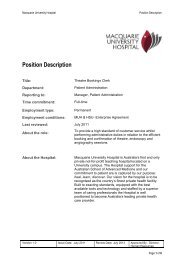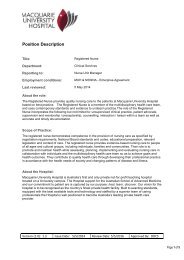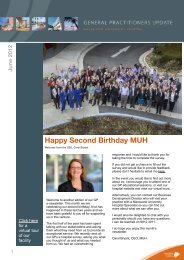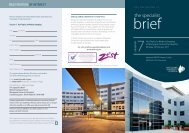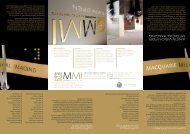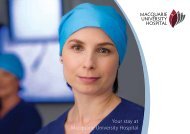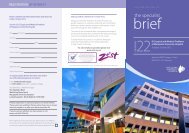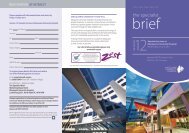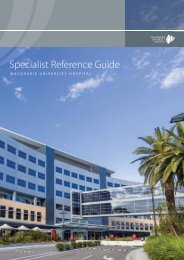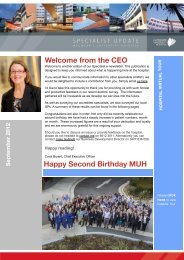reconstructive plastic surgery - Macquarie University Hospital
reconstructive plastic surgery - Macquarie University Hospital
reconstructive plastic surgery - Macquarie University Hospital
Create successful ePaper yourself
Turn your PDF publications into a flip-book with our unique Google optimized e-Paper software.
PlASTiC SuRGEOnS AT<br />
MACquARiE uniVERSiTY<br />
HOSPiTAl HAVE PlAYED A kEY<br />
ROlE in SAVinG AnD EnHAnCinG<br />
THE quAliTY Of lifE Of CHARliE<br />
AbDAllAH wHO SuffERED<br />
MASSiVE injuRiES AfTER A CAR<br />
ACCiDEnT in 2003.<br />
When Charlie Abdallah had a car accident<br />
almost nine years ago, he suffered multiple<br />
and extremely serious injuries. The injuries<br />
were primarily internal abdominal injuries –<br />
failed kidneys, bowel and bladder, as well as<br />
collapsed lungs. Compromised blood supply<br />
to the right leg eventually led to a<br />
hindquarter amputation.<br />
“Basically, everything stopped working,<br />
except my heart and my brain,” said Charlie.<br />
“I have no recollection of the accident. I only<br />
remember waking up in intensive care after<br />
about a month.”<br />
Charlie stayed in liverpool <strong>Hospital</strong> for a year<br />
and nine months, spending nine months in<br />
intensive care and a year on the wards.<br />
Since then, he has had twenty additional<br />
surgeries. Some have been elective, some<br />
emergency. Many of them have involved<br />
<strong>reconstructive</strong> <strong>plastic</strong> <strong>surgery</strong>, attempting to<br />
close large wounds or lessen the build-up of<br />
scar tissue.<br />
Associate Professor Anand Deva, Head of<br />
Plastic Surgery at <strong>Macquarie</strong> <strong>University</strong><br />
<strong>Hospital</strong>, has been actively involved in<br />
Charlie’s case since the night he was first<br />
admitted to hospital.<br />
Part of the team who worked hard to get<br />
him through those initial weeks, Professor<br />
Deva said that Charlie is one of the sickest<br />
patients he’s seen who has gone on to<br />
survive so remarkably.<br />
“Whilst I was consulted when he first came<br />
in, my first major involvement with Charlie’s<br />
recovery was in 2004, when we attempted<br />
to heal the abdominal and pelvic wounds<br />
that had not closed since the accident,” said<br />
Professor Deva. “Because urine and bowel<br />
contents were leaking through the wound,<br />
it became a matter of priority to look at<br />
ways of closing these wounds.<br />
“To accelerate healing, the team used a<br />
vacuum sponge dressing, a relatively<br />
new technology used to treat chronic,<br />
non-healing wounds. This provided a rapid<br />
closure and healthy bed on which to place<br />
skin grafts, which ultimately achieved<br />
complete healing and prevented further<br />
loss of blood and body fluids.”<br />
The <strong>plastic</strong> <strong>surgery</strong> team later operated to<br />
provide padding to Charlie’s pelvic area to<br />
allow him to mobilise on a wheelchair.<br />
Professor Deva also performed a cosmetic<br />
nose operation to correct the appearance<br />
and function of Charlie’s nose, which was<br />
fractured during the accident.<br />
Their biggest challenge came with the most<br />
recent operation, performed at <strong>Macquarie</strong><br />
<strong>University</strong> <strong>Hospital</strong> early in 2011. The<br />
operation involved two procedures<br />
simultaneously: an ileostomy reversal and<br />
an abdominal reconstruction to address<br />
abdominal hernias that had resulted from<br />
loss of the majority of Charlie’s abdominal<br />
muscle and skin.<br />
5



